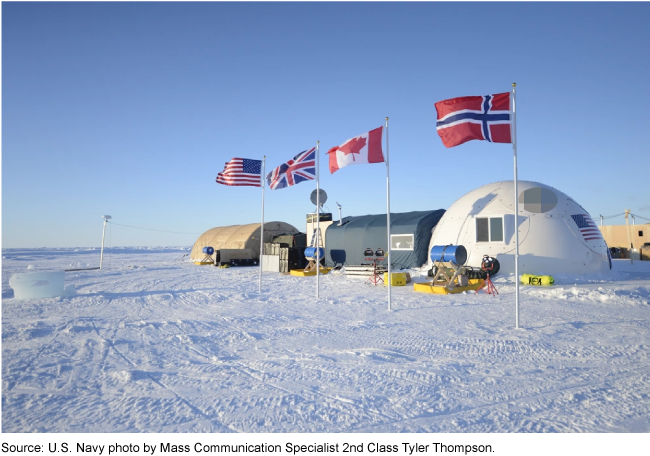Arctic Region: Factors That Facilitate and Hinder the Advancement of U.S. Priorities
Fast Facts
In the Arctic, warming temperatures and melting sea ice have opened new shipping routes but have also increased climate risks and international economic competition. Addressing these issues is a strategic priority for the U.S. government.
U.S. and foreign stakeholders identified factors that may help advance U.S. priorities, such as creating a new Ambassador for the Arctic region and providing scientific and other expertise at the Arctic Council—a forum that promotes cooperation among Arctic countries. But stakeholders also noted that challenges in interagency coordination and other areas may make some U.S. priorities harder to achieve.
A cooperative Arctic expedition in 2016

Highlights
What GAO Found
Management roles for advancing U.S. Arctic priorities span the federal government. In October 2022, the federal government published an updated Arctic strategy that serves as a framework for guiding its approach to addressing emerging challenges and opportunities in the Arctic. While many federal entities engage with foreign partners on Arctic issues, the Department of State serves as the lead for Arctic diplomacy efforts. The Biden administration announced that an existing Arctic coordinator position at State would be elevated to an Ambassador-at-Large position in August 2022, but the nominee has yet to be confirmed.
Map of the Arctic Region

Stakeholders identified five factors that facilitated and five factors that hindered the federal government's management of U.S. Arctic priorities. For example, stakeholders identified U.S. Arctic expertise and engagement as factors that facilitated its influence in the Arctic Council. However, some stakeholders said that the Arctic Executive Steering Committee and the broader federal government face various challenges related to interagency coordination that hinder implementation of U.S. Arctic priorities outlined in the 2022 strategy.
Stakeholders identified three factors pertaining to State's structures that facilitated and two factors that hindered State's management of U.S. Arctic priorities. For example, stakeholders identified continuity within the Senior Arctic Official position and supporting office as a factor that has deepened institutional knowledge for Arctic Council work, facilitating efforts to promote U.S. priorities. However, some stakeholders identified gaps in leadership and limited convening authority as factors that had hindered management. Many stakeholders viewed the announcement of the Ambassador-at-Large for the Arctic Region position positively but identified elements State and the new Ambassador should consider to manage U.S. Arctic priorities successfully going forward. These elements include consistency in position and title, a formalized office structure, clarity of Ambassador's role within the department, and greater authority to coordinate with all the relevant bureaus across the department.
Why GAO Did This Study
The United States, by virtue of Alaska, is an Arctic nation and has substantial interests in the region. In recent years, the effects of climate change, technological advancements, and economic opportunities have driven increasing interest and activity in the Arctic region. In addition, there has been an escalation of great power competition between the United States, Russia, and China, which seeks Arctic resources, among other things. This competition has introduced tension into the Arctic's geopolitical environment.
GAO was asked to review the federal government's management of Arctic efforts, including State's current structures for Arctic diplomacy. This report discusses (1) federal entities' roles in managing U.S. Arctic priorities, (2) factors stakeholders identified that may facilitate or hinder the federal government's management of U.S. Arctic priorities, and (3) factors stakeholders identified that may facilitate or hinder State's role in managing U.S. Arctic priorities.
GAO reviewed Arctic strategies, State documentation, and other relevant reports. GAO also interviewed 31 stakeholders, grouping similar stakeholders on the basis of their affiliations to create six groups for GAO's analysis and discussion. These groups were State, other agencies, U.S. experts on Arctic issues, foreign governments of Arctic countries, Alaska Native organizations, and the state government of Alaska. GAO selected these groups to capture a range of perspectives concerning any factors that may facilitate or hinder the federal government's or State's management of U.S. Arctic priorities.
For more information, contact Chelsa Kenney at (202) 512-2964 or kenneyc@gao.gov.
